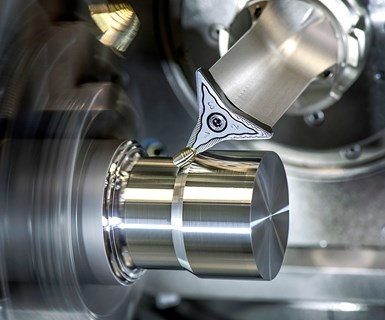Ceratizit's FreeTurn Tooling Combines Different Cutting Edge Properties for Flexibility
Ceratizit’s FreeTurn tooling is designed to be used with its High Dynamic Turning (HDT) method, which is said to enable roughing, finishing, contour turning, face turning and longitudinal turning with a single tool.
Share






Ceratizit’s FreeTurn tooling is designed to be used with its High Dynamic Turning (HDT) method, which is said to enable roughing, finishing, contour turning, face turning and longitudinal turning with a single tool. FreeTurn tooling features a multi-sided insert at the cutting end of the slim shank. The insert, which screws into place, can have several cutting edges with different properties. This is said to allow for different angle points, corner radii or chipbreakers as well as different coatings and cutting materials. The tool can therefore be adapted to do specific machining requirements and provide savings in tool change times, tool magazine loadouts and overall tool costs, according to the company.
In the HDT method, the milling spindle is used to produce the corresponding approach angle to the workpiece. The use of the spindle drive in conjunction with the slim, axial design of FreeTurn tools is said to create a degree of freedom of 360 degrees without the risk of collision, the company says. Due to the rotation around its own tool axis, the cutting edge can be changed without interrupting the process. Additionally, the angle of approach is freely variable at any time and can even be changed while cutting, enabling flexible contouring and optimizing chip breaking for higher feed rates and longer tool life.
Related Content
-
Toolpath Improves Chip Management for Swiss-Type Lathes
This simple change to a Swiss-type turning machine’s toolpath can dramatically improve its ability to manage chips.
-
How to Mitigate Chatter to Boost Machining Rates
There are usually better solutions to chatter than just reducing the feed rate. Through vibration analysis, the chatter problem can be solved, enabling much higher metal removal rates, better quality and longer tool life.
-
Orthopedic Event Discusses Manufacturing Strategies
At the seminar, representatives from multiple companies discussed strategies for making orthopedic devices accurately and efficiently.


















.jpg;maxWidth=300;quality=90)

